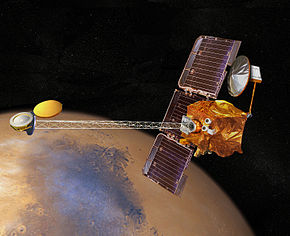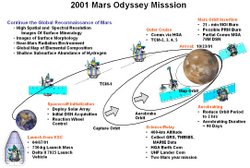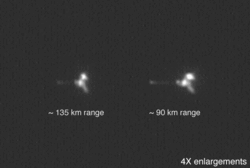- 2001 Mars Odyssey
-
2001 Mars Odyssey 
Conceptual drawing of 2001 Mars Odyssey over Mars.Operator NASA Mission type Orbiter Satellite of Mars Orbital insertion date 2001-10-24 02:18:00 UTC Launch date 2001-04-07 15:02:22 UTC
(10 years, 7 months and 14 days ago)Launch vehicle Delta II 7425 Launch site Space Launch Complex 17A
Cape Canaveral Air Force StationMission duration In progress (Extended Mission)
(9 years, 9 months and 22 days elapsed)
Primary mission
(completed 2004-08-24)COSPAR ID 2001-014A Homepage Mars Odyssey: Overview Mass 376 kg (830 lb) Power 750 W (Photovoltaic array/NiHM Battery) Orbital elements Semimajor axis 3785 km (~400 km above surface) Eccentricity 0.0115 Inclination 93.2 deg Orbital period 1.964 hours 2001 Mars Odyssey is a robotic spacecraft orbiting the planet Mars. The project was developed by NASA, and contracted out to Lockheed Martin, with an expected cost for the entire mission of US$297 million. Its mission is to use spectrometers and electronic imagers to hunt for evidence of past or present water and volcanic activity on Mars. It is hoped that the data Odyssey obtains will help answer the question of whether life has ever existed on Mars. It also acts as a relay for communications between the Mars Exploration Rovers and the Phoenix lander to Earth. The mission was named as a tribute to Arthur C. Clarke, evoking the name of 2001: A Space Odyssey [1].
Odyssey was launched April 7, 2001 on a Delta II rocket from Cape Canaveral Air Force Station, and reached Mars orbit on October 24, 2001, at 2:30 a.m. UTC (October 23, 7:30 p.m. PDT, 10:30 p.m. EDT). The spacecraft's main engine fired in order to brake the spacecraft's speed, which allowed it to be captured into orbit around Mars. Odyssey used a technique called "aerobraking" that gradually brought the spacecraft closer to Mars with each orbit. By using the atmosphere of Mars to slow down the spacecraft in its orbit, rather than firing its engine or thrusters, Odyssey was able to save more than 200 kilograms (440 lb) of propellant. Aerobraking ended in January, and Odyssey began its science mapping mission on February 19, 2002.
By December 15, 2010 it broke the record for longest serving spacecraft at Mars, with 3,340 days of operation, claiming the title from NASA's Mars Global Surveyor.[2] As of late 2011 it holds the record (10+ years) for the longest-surviving continually active spacecraft in orbit around a planet other than Earth.
Contents
Naming
Mars Odyssey was originally a component of the Mars Surveyor 2001 program, and was named the Mars Surveyor 2001 Orbiter. It was intended to have a companion spacecraft known as Mars Surveyor 2001 Lander, but the lander mission was canceled in May 2000 following the failures of Mars Climate Orbiter and Mars Polar Lander in late 1999. Subsequently, the name 2001 Mars Odyssey was selected for the orbiter as a specific tribute to the vision of space exploration shown in works by Arthur C. Clarke, including 2001: A Space Odyssey. The music from Mythodea by Greek composer Vangelis was used as the theme music for the mission.
Scientific instruments
The three primary instruments Odyssey uses are the:
- Thermal Emission Imaging System (THEMIS).[3]
- Gamma Ray Spectrometer (GRS),[4] includes the High Energy Neutron Detector (HEND), provided by Russia.
On May 28, 2002, NASA reported that Odyssey's GRS had detected large amounts of hydrogen, a sign that there must be ice lying within a meter of the planet's surface. GRS is a collaboration between University of Arizona's Lunar and Planetary Lab., the Los Alamos National Laboratory, and Russia's Space Research Institute.
Mission
Odyssey has served as the primary means of communications for NASA’s Mars surface explorers in the past decade and will continue that role for the upcoming Curiosity rover. About 85 percent of images and other data from NASA's twin Mars Exploration Rovers, Spirit and Opportunity, have reached Earth via communications relay by Odyssey. Odyssey continues to receive transmissions from the surviving rover every day. The orbiter helped analyze potential landing sites for the rovers and performed the same task for NASA's Phoenix mission, which landed on Mars in May, 2008. Odyssey aided NASA's Mars Reconnaissance Orbiter, which reached Mars in March 2006, by monitoring atmospheric conditions during months when the newly arrived orbiter used aerobraking to alter its orbit into the desired shape.
On September 30, 2008 the spacecraft altered its orbit to gain better sensitivity for its infrared mapping of Martian minerals. The new orbit eliminated the use of the gamma ray detector, due to the potential for overheating the instrument at the new orbit.
NASA has approved a fourth two year extended mission, through August 2012, to allow for the observation of year-to-year differences in phenomena like polar ice, clouds, and dust storms, as well as a much more sensitive mapping of martian minerals. A fifth extended mission (to July 2014) would be likely if Curiosity lands successfully in late 2012. The orbiter contains enough propellant to operate at least until 2015. In 2010, a spokesman for NASA's Jet Propulsion Laboratory stated that Odyssey could continue operating until at least about 2016 and "perhaps even well beyond". [5]
As of late 2010, THEMIS and two parts of the GRS suite — the neutron spectrometer and the high-energy neutron detector — are currently in use. The third sensor for that suite — the gamma ray detector — is not currently in use. The payload’s MARIE radiation experiment stopped taking measurements after a large solar event bombarded the Odyssey spacecraft on October 28, 2003. Engineers believe the most likely cause is that a computer chip was damaged by a solar particle smashing into the MARIE computer board.
Water on Mars
On July 31, 2008, NASA announced that the Phoenix lander confirmed the presence of water on Mars,[6] as predicted in 2002 based on data from the Odyssey orbiter. The science team is trying to determine whether the water ice ever thaws enough to be available for biology, and if carbon-containing chemicals and other raw materials for life are present.
See also
- Exploration of Mars
- Mars Student Imaging Project (MSIP)
- Nickel hydrogen battery
- Space exploration
References
- ^ NASA JPL mission overview page
- ^ Press Release
- ^ P. R. Christensen, B. M. Jakosky, H. H. Kieffer, M. C. Malin, H. Y. McSween Jr., K. Nealson, G. L. Mehall, S. H. Silverman, S. Ferry, M. Caplinger, M Ravine (2004). "The Thermal Emission Imaging System (THEMIS) for the Mars 2001 Odyssey Mission". Space Science Reviews 110 (1-2): 85. Bibcode 2004SSRv..110...85C. doi:10.1023/B:SPAC.0000021008.16305.94.
- ^ W.V. Boynton, W.C. Feldman, I.G. Mitrofanov, L.G. Evans, R.C. Reedy, S.W. Squyres, R. Starr, J.I. Trombka, C. d'Uston, J.R. Arnold, P.A.J. Englert, A.E. Metzger, H. Wänke, J. Brückner, D.M. Drake, C. Shinohara, C. Fellows, D.K. Hamara, K. Harshman, K. Kerry, C. Turner, M. Ward1, H. Barthe, K.R. Fuller, S.A. Storms, G.W. Thornton, J.L. Longmire, M.L. Litvak, A.K. Ton'chev (2004). "The Mars Odyssey Gamma-Ray Spectrometer Instrument Suite". Space Science Reviews 110 (1-2): 37. Bibcode 2004SSRv..110...37B. doi:10.1023/B:SPAC.0000021007.76126.15.
- ^ http://www.universetoday.com/81675/the-longest-martian-odyssey-ever/ (2010 Universe Today article on Mars Odyssey)
- ^ Confirmation of Water on Mars
External links
- The Mars Odyssey site
- The Mars Odyssey blog
- Mars 2001 Odyssey Mission Profile by NASA's Solar System Exploration
- BBC News story on Mars Odyssey observations of apparent ice deposits
Spacecraft missions to Mars Flybys 
Orbiters Mariner 9 · Mars 2 · 3 · 5 · Viking 1 · 2 · Phobos 2 · Mars Global Surveyor · 2001 Mars Odyssey · Mars Express · Mars Reconnaissance Orbiter · Fobos-Grunt · Yinghuo-1
Landers Rovers Planned missions Mars Science Laboratory (2011) · MetNet · MAVEN (2013) ·
ExoMars static lander and rover · ExoMars Trace Gas Orbiter (2016) · Northern LightUnplanned missions Related topics Exploration · Colonization · Failed Mars missions · Mars Scout Program
Bold italics indicate active missions← 2000 · Orbital launches in 2001 · 2002 → Shenzhou 2 | Turksat 2A | Progress M1-5 | USA-156 | Sicral 1 · Skynet 4F | STS-98 (Destiny) | Odin | Progress M-44 | USA-157 | STS-102 (Leonardo MPLM) | Eurobird 1 · BSat-2A | XM-2 | Ekran-M #18L | Mars Odyssey | GSAT-1 | STS-100 (Raffaello MPLM) | Soyuz TM-32 | XM-1 | PAS-10 | USA-158 | Progress M1-6 | Kosmos 2377 | Kosmos 2378 | Intelsat 901 | Astra 2C | ICO F2 | MAP | STS-104 (Quest) | Artemis · BSat-2B | Molniya-3K #11 | GOES 12 | Koronas-F | USA-159 | Genesis | STS-105 (Leonardo MPLM · Simplesat) | Progress M-45 | Kosmos 2379 | VEP-2 · LRE | Intelsat 902 | USA-160 | Progress M-SO1 (Pirs) | OrbView-4 · QuickTOMS · SBD · Odyssey | Atlantic Bird 2 | Starshine 3 · PICOSat · PCSat · SAPPHIRE | USA-161 | Globus #14L | USA-162 | QuickBird-2 | Soyuz TM-33 | TES · PROBA · BIRD-1 | Molniya-3 #64 | Progress M1-7 (Kolibri 2000) | DirecTV-4S | Kosmos 2380 · Kosmos 2381 · Kosmos 2382 | STS-108 (Raffaello MPLM · Starshine 2 | Jason-1 · TIMED | Meteor-3M #1 · Kompass · Badr-B · Maroc-Tubsat · Reflektor | Kosmos 2383 | Kosmos 2384 · Kosmos 2385 · Kosmos 2386 · Gonets-D1 #10 · Gonets-D1 #11 · Gonets-D1 #12Payloads are separated by bullets ( · ), launches by pipes ( | ). Manned flights are indicated in bold text. Uncatalogued launch failures are listed in italics. Payloads deployed from other spacecraft are denoted in brackets.Categories:- 2001 Mars Odyssey
- Artificial satellites orbiting Mars
- Active extraterrestrial probes
- 2001 in spaceflight
- Spacecraft launched by Delta II rockets
- Mars spacecraft
Wikimedia Foundation. 2010.



